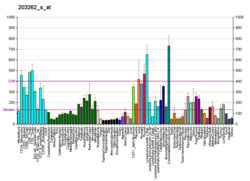| FAM50A | |||||||||||||||||||||||||||||||||||||||||||||||||||
|---|---|---|---|---|---|---|---|---|---|---|---|---|---|---|---|---|---|---|---|---|---|---|---|---|---|---|---|---|---|---|---|---|---|---|---|---|---|---|---|---|---|---|---|---|---|---|---|---|---|---|---|
| Identifiers | |||||||||||||||||||||||||||||||||||||||||||||||||||
| Aliases | FAM50A, 9F, DXS9928E, HXC-26, HXC26, XAP5, family with sequence similarity 50 member A, MRXSA | ||||||||||||||||||||||||||||||||||||||||||||||||||
| External IDs | OMIM: 300453; MGI: 1351626; HomoloGene: 3448; GeneCards: FAM50A; OMA:FAM50A - orthologs | ||||||||||||||||||||||||||||||||||||||||||||||||||
| |||||||||||||||||||||||||||||||||||||||||||||||||||
| |||||||||||||||||||||||||||||||||||||||||||||||||||
| |||||||||||||||||||||||||||||||||||||||||||||||||||
| |||||||||||||||||||||||||||||||||||||||||||||||||||
| |||||||||||||||||||||||||||||||||||||||||||||||||||
| Wikidata | |||||||||||||||||||||||||||||||||||||||||||||||||||
| |||||||||||||||||||||||||||||||||||||||||||||||||||
Protein FAM50A is a protein that in humans is encoded by the FAM50A gene.
References
- ^ GRCh38: Ensembl release 89: ENSG00000071859 – Ensembl, May 2017
- ^ GRCm38: Ensembl release 89: ENSMUSG00000001962 – Ensembl, May 2017
- "Human PubMed Reference:". National Center for Biotechnology Information, U.S. National Library of Medicine.
- "Mouse PubMed Reference:". National Center for Biotechnology Information, U.S. National Library of Medicine.
- Mazzarella R, Pengue G, Yoon J, Jones J, Schlessinger D (Nov 1997). "Differential expression of XAP5, a candidate disease gene". Genomics. 45 (1): 216–9. doi:10.1006/geno.1997.4912. PMID 9339379.
- Toyoda A, Sakai T, Sugiyama Y, Kusuda J, Hashimoto K, Maeda H (May 1997). "Isolation and analysis of a novel gene, HXC-26, adjacent to the rab GDP dissociation inhibitor gene located at human chromosome Xq28 region". DNA Res. 3 (5): 337–40. doi:10.1093/dnares/3.5.337. PMID 9039504.
- "Entrez Gene: FAM50A family with sequence similarity 50, member A".
Further reading
- Chen EY, Zollo M, Mazzarella R, et al. (1997). "Long-range sequence analysis in Xq28: thirteen known and six candidate genes in 219.4 kb of high GC DNA between the RCP/GCP and G6PD loci". Hum. Mol. Genet. 5 (5): 659–68. doi:10.1093/hmg/5.5.659. PMID 8733135.
- Sedlacek Z, Münstermann E, Dhorne-Pollet S, et al. (1999). "Human and mouse XAP-5 and XAP-5-like (X5L) genes: identification of an ancient functional retroposon differentially expressed in testis". Genomics. 61 (2): 125–32. doi:10.1006/geno.1999.5931. PMID 10534398.
- Hartley JL, Temple GF, Brasch MA (2001). "DNA cloning using in vitro site-specific recombination". Genome Res. 10 (11): 1788–95. doi:10.1101/gr.143000. PMC 310948. PMID 11076863.
- Strausberg RL, Feingold EA, Grouse LH, et al. (2003). "Generation and initial analysis of more than 15,000 full-length human and mouse cDNA sequences". Proc. Natl. Acad. Sci. U.S.A. 99 (26): 16899–903. Bibcode:2002PNAS...9916899M. doi:10.1073/pnas.242603899. PMC 139241. PMID 12477932.
- Gerhard DS, Wagner L, Feingold EA, et al. (2004). "The status, quality, and expansion of the NIH full-length cDNA project: the Mammalian Gene Collection (MGC)". Genome Res. 14 (10B): 2121–7. doi:10.1101/gr.2596504. PMC 528928. PMID 15489334.
- Wiemann S, Arlt D, Huber W, et al. (2004). "From ORFeome to biology: a functional genomics pipeline". Genome Res. 14 (10B): 2136–44. doi:10.1101/gr.2576704. PMC 528930. PMID 15489336.
- Ross MT, Grafham DV, Coffey AJ, et al. (2005). "The DNA sequence of the human X chromosome". Nature. 434 (7031): 325–37. Bibcode:2005Natur.434..325R. doi:10.1038/nature03440. PMC 2665286. PMID 15772651.
- Mehrle A, Rosenfelder H, Schupp I, et al. (2006). "The LIFEdb database in 2006". Nucleic Acids Res. 34 (Database issue): D415–8. doi:10.1093/nar/gkj139. PMC 1347501. PMID 16381901.
This article on a gene on the human X chromosome and/or its associated protein is a stub. You can help Misplaced Pages by expanding it. |




